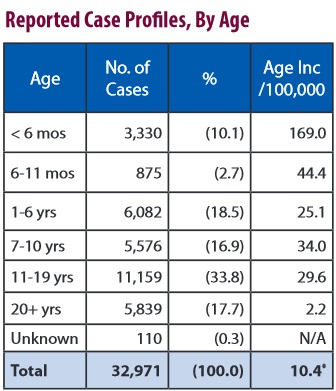Pertussis epidemiology and demographics
Editor-In-Chief: C. Michael Gibson, M.S., M.D. [1]; Associate Editor(s)-in-Chief: Aditya Govindavarjhulla, M.B.B.S. [2]
|
Pertussis Microchapters |
|
Diagnosis |
|---|
|
Treatment |
|
Case Studies |
|
Pertussis epidemiology and demographics On the Web |
|
American Roentgen Ray Society Images of Pertussis epidemiology and demographics |
|
Risk calculators and risk factors for Pertussis epidemiology and demographics |
Overview
Pertussis results in high morbidity and mortality in many countries every year. Pertussis causes 20-40 million deaths worldwide, the majority of which occur in Africa and Southeast Asia.
Epidemiology and Demographics

Incidence
- In the United States, 5000-7000 cases are reported each year.
- Incidence of pertussis has increased steadily since the 1980s.
- The incidence in 2002 was 3.01/100,000 when 8,296 cases of pertussis were reported.
- The Center for Disease Control and prevention (CDC) reported the incidence of pertussis in 2005 to be 25,616, which is triple the incidence reported in 2001.
- There are several hypothesized reasons for the increase in incidence:
- Decreased use of the vaccination.
- Decrease in the level of vaccine induced immunity over the years.
- Increased circulation of the pathogen itself.
- The following have been enacted to decrease incidence of pertussis and increase efficacy of treatment:
- Heightened awareness of whooping cough among health care providers.
- An increased amount of public health reporting.
- The increased sensitivity of PCR testing to diagnose pertussis.
Susceptible Populations
- Outbreaks of pertussis occur in under-vaccinated or un-vaccinated populations of individuals, such as those in particular religious communities.
- Outbreaks have also occurred in settings such as sports facilities, schools and health care facilities, where an infected individual has not been diagnosed and the infection has spread.
- In adults and adolescents, pertussis may simply present as a prolonged cough and poses a great risk of exposure to young and immunocompromised contacts.
- The highest incidence of infection occurs in infants and young children.
Reported Pertussis Death versus Age
- In 2014, a total of 13 Pertussis related deaths were reported in the United States.
- Eight deaths were reported within infants of less than 3 months.
- One death was reported within infants of between the ages of 3-11 months.
- Two deaths were reported within children ages of 1-4 years.
- Two deaths were reported within adults of ages 55+.
Age
- The number of reported cases has increased in all age groups, but the increase is greatest among persons aged greater than or equal to 5 years.
- Nevertheless, infants and young children continue to have the highest risk for pertussis and its complications, with 84% of the deaths due to pertussis occurring in infants less than 6 months of age.
- In 2014, 32,971 cases of Pertussis were been reported within the United States.
- 3,330 cases were reported in infants less than 6 months, accounting for 10.1% of all cases.
- 875 cases were reported within infants between the ages of 6-11 months, accounting for 2.7% of all cases.
- 6,082 cases were reported within children between 1-6 years of age, accounting for 18.5% of all cases.
- 5,576 cases were reported within children between the ages of 7-10 years, accounting for 16.9% of all cases.
- 11,159 cases were reported within children and teenagers between the ages of 11-19 years, accounting for 33.8% of all cases.
- 5,839 cases were reported within adults of 20+ years, accounting for 17.7& of all cases.

- Children below the age of 1 year are mostly affected.
- Incidence decreases with increasing age.[1]
Gender
- Gender is not associated with an increased risk of pertussis.[1]
References
- ↑ 1.0 1.1 Mattoo S, Cherry JD (2005). "Molecular pathogenesis, epidemiology, and clinical manifestations of respiratory infections due to Bordetella pertussis and other Bordetella subspecies". Clin. Microbiol. Rev. 18 (2): 326–82. doi:10.1128/CMR.18.2.326-382.2005. PMC 1082800. PMID 15831828. Unknown parameter
|month=ignored (help)